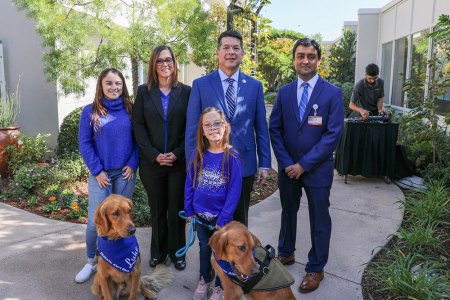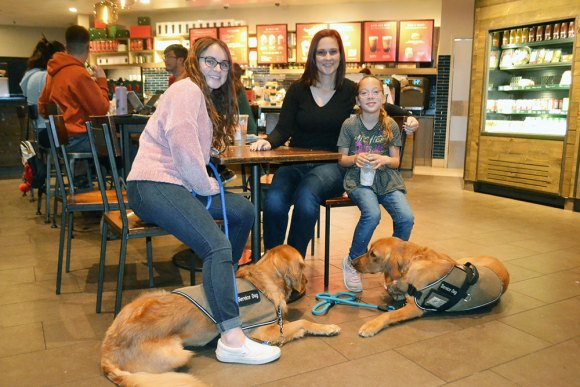Dealing with Type 1 Diabetes: Lemoore family, congressman, bring Central Valley's attention to the high cost of medical care
They – golden retrievers excluded – were busy sipping Starbuck’s concoctions as Lazer and Luke, the two dogs, visibly unimpressed by my arrival, decided instead to ignore me, remaining sequestered beneath a Starbucks table, leaving me to fend by myself.
These dogs are more than just pets. Despite their apparent indifference towards newspaper editors, their job – and it’s an important one – is to keep a close watch on both Breana and Kandace, both of whom have Type 1 Diabetes. They are service dogs, explicitly trained to react when a problem with blood sugar occurs, as is often the case with diabetics.
However, costly medical treatments, including specially trained service dogs, don’t come cheap. These pooches “retail” for $12,000 apiece, thus adding yet another hefty medical expense to the Jones’ household.
Twenty-four thousand dollars is certainly a significant sum, prompting the family to wisely create a GoFundMe page to help defray the cost of the two dogs.
Visit the family’s GoFundMe account
Type 1 Diabetes, also referred to as juvenile diabetes, is a chronic condition in which the pancreas produces little or no insulin. Insulin is a hormone needed to allow sugar (glucose) to enter cells to produce energy. Although Type 1 Diabetes usually appears during childhood or adolescence, it can certainly develop in adults.

Kandace developed diabetes in 2015 when she was three years old. Breana, 16, was only recently diagnosed. “We caught hers a lot earlier than Kandace because we were more aware of the symptoms,” said her mother, Vicki.
Type 1 symptoms include increased thirst, frequent urination, bed-wetting, extreme hunger, unintended weight loss, irritability and other mood changes, fatigue, and blurred vision.
My interest in the Jones’ family story began with a press release from our local congressman, TJ Cox. His release focused on the costs associated with diabetes care. I contacted Jones and asked if she’d be willing to speak with me. Jones, the mother of five, recently appeared with Cox at a Bakersfield press conference where the two of them talked about juvenile (Type 1) diabetes and the toll it often takes on families and their finances.
“He’s really concerned about health care overall and lowering the cost of medications,” said Jones of Cox. “He’s been very supportive of funding research for Type 1 Diabetes.”
Cox seems to have taken a keen interest in Valley health issues. As a member of the House of Representatives Asthma and Allergy Caucus, he recently helped to introduce legislative efforts to expand the Centers for Disease Control and Prevention’s National Asthma Control Program.
To find out more about the impact of diabetes in the Central Valley, Cox asked Jones to talk about her experiences in dealing with the high cost of diabetes care. “As a member of Congress representing California’s 21st Congressional District, I thought it was important to find out the impact of diabetes in the Central Valley communities I represent,” he said.
Other voices brought to light the seriousness of diabetes. “If you look at cases of diabetes around the country, the national average is only 10 percent,” said Bakersfield endocrinologist, Dr. Harshit Shah, who also attended the press conference. “However, here in Kern County, the average is 30.3 percent. For those over the age of 45 living in our community, it’s about 25 percent, almost twice the national average for those with Type 2 Diabetes.”
Breana and Kandace, both having Type 1 Diabetes, will likely remain insulin-dependent for the rest of their lives. And indeed, despite having good insurance, Jones and husband Brandon routinely pay $400 to $500 out of pocket for the live-saving drugs needed for their children – not to mention the cost of two specially trained golden retrievers.
“With the cost of insulin and other diabetic supplies being so high, we’re fortunate to have insurance, but it’s still a financial burden,” said Jones as her daughters sipped their Starbucks drinks, and the two dogs remained silently ensconced beneath our table. “But it’s even a bigger burden on people who don’t have insurance or good insurance. And some families are having to choose between getting their life-saving medications for their children or paying their rent.
“It’s unfortunate that a lot of people have to make that tough decision. Also, college students who don’t have the means to pay for their prescriptions are rationing their insulin because the cost is so high. There have been college students that have ended up in the hospital because of being in diabetic ketoacidosis, which occurs when a patient’s blood sugar is so high the body is producing acids that basically attack your organs, eventually causing damage.”
Sometimes, it seems to come down to costs. Jones told me that the reason blood sugar gets so high is that some patients ration their insulin. “They’re not giving themselves the right amount of insulin, because they don’t have the money to buy their insulin every month.
“There are people without insurance or don’t have insurance with good coverage, and so they’re paying out of pocket, and so they have to choose between paying the bills or paying for their medication.”
Lazer and Luke, lovable and friendly as they are, have an essential job to do, and that’s to keep a close eye on their young handlers. “They can sense when the sugar level is dropping. They can smell it,” said Jones. “The dogs alert them as the blood sugar is dropping.”
Fewer emergency room visits are just one of the benefits derived from the dogs. They can detect a problem before it becomes severe.
Unfortunately, said Jones, medical insurance doesn’t cover the dogs, but she said that they’re worth every penny.
Both Lazer and Luke were trained locally, in Woodlake, at the Assistance Service Dog Educational Center (ASDEC). Founded in 2002 by Gerald and Donna Whittaker, ASDEC trains and provides service dogs to clients with needs such as mental or physical disabilities and medical conditions such as seizures or diabetes.
The agency also helps veterans with Post Traumatic Stress Disorder (PTSD). The Whittakers have placed over 400 dogs since its inception.
“We have dogs in 31 states,” said Gerald Whittaker, who has been training dogs in one way or the other since he was eight years old. “We’ve been doing this program for 18 years now.”
Dogs like Lazer and Luke may begin their specific training at about two years old. In this case, both dogs were trained to detect ketones, the chemicals produced by the liver, created when you don’t have enough insulin in your body to turn sugar into energy. “We train them to smell the ketones. It’s a fruity smell, and they can smell it through their breath. They smell that, and it alerts the dogs,” said Whittaker.
He also said that Lazer and Luke were quick learners. “Every dog is a little different,” he said. “Sometimes it takes six months, sometimes two months.”
“We have dogs that will detect seizures and dogs that can pick up things off the floor, turn lights off and on, and remove clothes from the dryers. They end up learning 90 commands, and with those commands, you can do a lot of stuff.”
Whittaker and his wife Donna, whom he credits with the program’s creation, are especially proud of their recent work with veterans. “What we’ve been doing lately is working with veterans. If they’re missing a limb, they (dogs) can help pick up stuff.”
He’s also proud of his work with veterans with PTSD. “A lot of times a person’s not comfortable out in public and the dogs (help them cope). They’re just a big comfort, and they’re with them 24 hours a day.”
Gerald and Donna typically train about 20 dogs at a time. The couple also breeds their own dogs.
Mostly volunteers staff Their program. Ten to 15 people spend time helping the Whittakers train their service dogs.
Living with diabetes is an ongoing issue. The family, in addition to local care, visits the Valley Children’s Hospital Diabetic Clinic near Fresno about every three months where specialists in diabetes can check up on the girls. Until medical science identifies a cure for this affliction and others, there will always be help, in the form of doctors, family, or even a pair of loving golden retrievers.
Local News
- Summer of fun, Second Annual Bash, held recently at Veterans Park for kids and adults
- Lemoore High grads celebrate another rite of passage as large class gives fond farewell to school years
- West Hills men's basketball team takes next step in NorCal basketball after impressive win against Delta College
- West Hills College Lemoore students earn STEM scholarships to study Biology, Engineering, Physics, and Math
- A Christmas tree tradition renews and Christmas Parade scheduled for Dec. 2
- Local volunteers and former teachers go the extra mile to spruce up and beautify Downtown Lemoore
_0.jpg)

.jpg)





